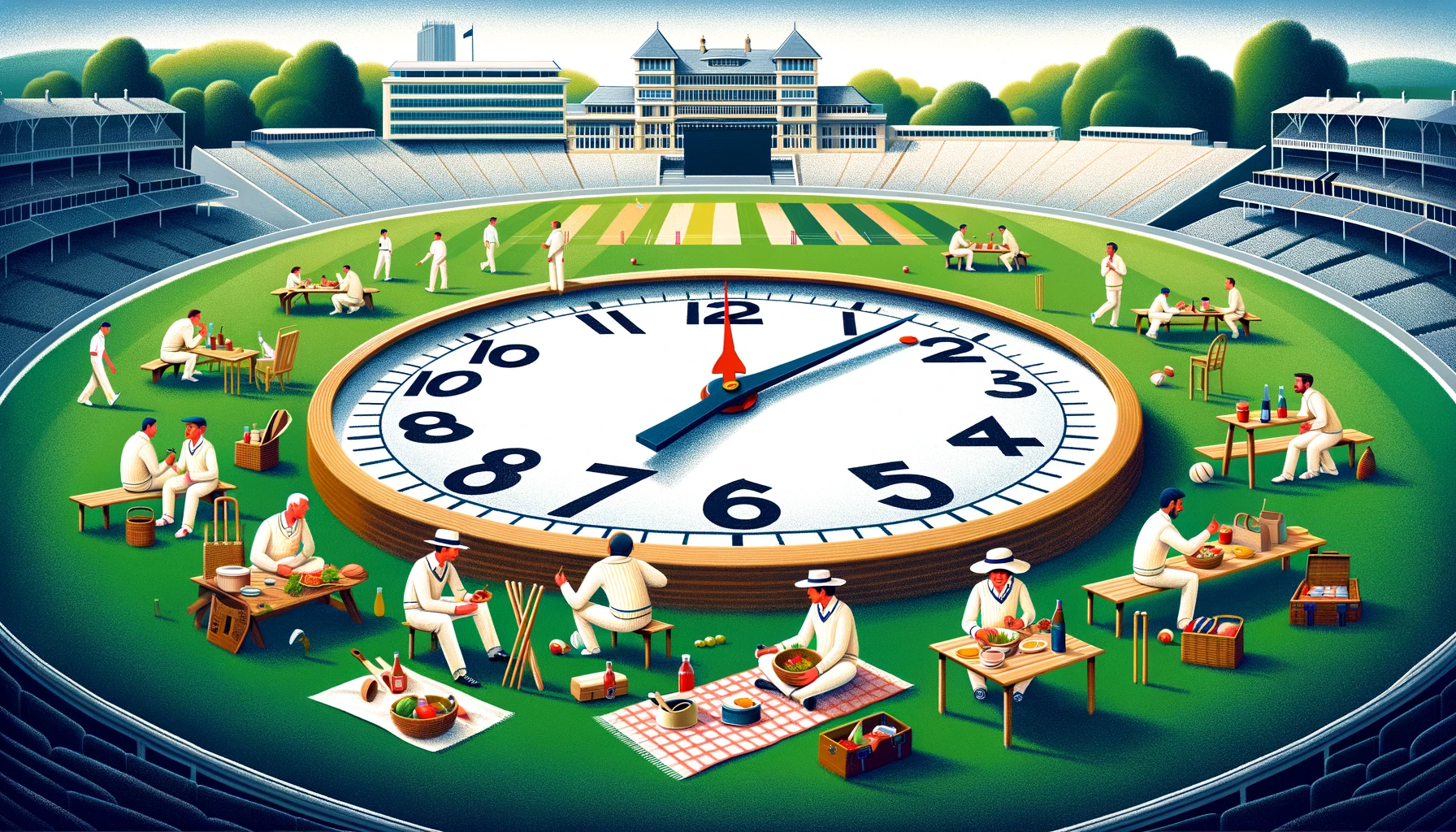[ad_1]
When we’re engrossed in the riveting world of Test cricket, the ebb and flow of the game isn’t just about the runs and wickets. It’s also about the well-deserved breaks that punctuate the day. The lunch interval, a cricketing tradition, offers players and fans alike a moment to catch their breath.
In this article, we’ll delve into the specifics of the lunch break in Test cricket. How long do players get to refuel and strategise? We’re here to give you the lowdown on this essential part of the game’s rhythm, ensuring you’re well-versed in the intricacies of cricket’s time-honoured customs.
The Significance of the Lunch Break in Test Cricket
Test cricket’s natural ebb and flow are defined by its periodic pauses, with the lunch break taking center stage. It doesn’t just mark a pause in play; it separates the morning and afternoon sessions, offering athletes a crucial period to regroup. We understand that at its core, cricket is not just a game of skill but also one of endurance and concentration. Here’s where the importance of the lunch break comes into sharp focus.
At 40 minutes, the lunch break is the most extended interval during a day’s play in Test cricket. Starting around 1pm BST for matches commencing at 11am, players leverage this time to carefully consider their nutritional intake. Properly fueling the body is essential, not just in supporting physical exertion but also in maintaining mental sharpness for the challenges ahead.
The timing of the lunch break itself is delicately positioned – precisely two hours into the day’s play. This ensures that players are neither overtaxed nor under-engaged. We’ve observed that even though they’ve been on the field for considerable time, their performance doesn’t wane after the break, highlighting the significance of this interval.
The duration of the breaks in Test cricket is no mere convenience; it’s a thoughtful construct that respects the intricacies of the sport.
| Break | Duration |
|---|---|
| Lunch Break | 40m |
| Tea Break | 20m |
By breaking down the sessions into manageable slots, the players can push themselves hard during play knowing a well-timed respite is just around the corner.
It’s not just the physical benefits that we note; the psychological boost cannot be overstated. A well-earned break can reignite a batsman’s focus or offer a bowler the chance to strategize their next spell. The rhythm of the day’s cricket hinges on these intervals, and the lunch break anchors this rhythm with thoughtful timing and duration, exemplifying the tactical nuances embedded in the tradition of the sport.
The Traditions and Customs Surrounding the Lunch Interval
In the intricate tapestry of Test cricket, the lunch interval is woven with a series of traditions and customs that honour the game’s rich history. Beyond the call of “Time” signaling a pause in play, the 40-minute lunch break is a moment deeply embedded in the culture of cricket, echoing the sport’s longstanding values of fair play and respect.
Cricket, after all, respects the well-being of its players, with regulations in place ensuring everyone’s on the same page. Law 11.2.1 of the game’s guiding principles stipulates that the duration of a lunch interval is agreed upon under consultation with captains. This coordination ensures that every match retains a certain standardized rhythm.
The break also acts as a bridge connecting the morning and afternoon sessions. It isn’t just about fueling the body with nutrition; it’s about adopting a strategic mindset. Planning over lunch can influence the course of the game, where discussions on tactics and approaches for the upcoming session takes precedence. The 40-minute interval provides players and coaches the necessary time to evaluate and adapt to the day’s progression.
| Session | Duration | Interval Type | Interval Duration |
|---|---|---|---|
| First (Pre-Lunch) | 2 hours | Lunch | 40 minutes |
| Second (Post-Lunch) | 2 hours | Tea | 20 minutes |
| Third (Post-Tea) | 2.5 hours | None | None |
As we understand it, time away from the field is critical for players to maintain their intensity and performance levels. The conventions in place, such as Law 11.5.3, protect the sanctity of the lunch break. Even if play is interrupted, lunch is taken at the agreed upon time unless both captains and umpires decide otherwise.
Moreover, the viewing public has a vested interest in the sharpness and vitality of the players—it enhances the viewing experience. Just as actors need an intermission, cricketers require this interval to keep delivering a top-notch spectacle.
The Duration of the Lunch Break: How Long Do Players Get?
Let’s delve into the specifics of this pivotal interval. The lunch break is undisputedly the longest halt in play within a Test match, lasting precisely 40 minutes. This pause commences two hours after the start of the day’s play and is considered the first and most significant scheduled intermission of the day. Test cricket, with its unique rhythm, designates this time for players to boost their stamina for the remaining sessions.
Test cricketers cannot simply rely on sandwiches and cake for sustenance, unlike in club cricket. Instead, their lunch period is a crucial time for careful nutritional intake to help maintain peak physical condition and concentration levels. The food choices made during this period can have a substantial impact on their performance in the post-lunch session.
Every Test match day is structured with start and finish times that consider the need for breaks. With a start time of 11 am, two hours of play precede the lunch break, signalling the players to retreat momentarily from the field. After lunch, play resumes at 1.40 pm – an optimal schedule that aligns with players’ physiological needs.
| Break | Duration | Start Time | Resumption Time |
|---|---|---|---|
| Lunch | 40 mins | 1 pm | 1.40 pm |
The game’s governing bodies have enshrined the lunch interval timings to ensure that there is no overextension in the morning session. Not only does this protect the physical welfare of the athletes, but it also enhances the quality of cricket showcased to the viewing public who eagerly anticipate top-tier performance throughout the day.
Essentially, the lunch break in Test cricket plays a central role in dividing the day’s activities. It not only gives players the needed respite from consistent physical exertion but also holds space for strategic discussions and mental preparations for the hours of skilful play that lie ahead.
How Players Utilize the Lunch Break for Rest and Strategic Planning
During the arduous hours of play in a Test cricket match, the lunch break emerges as a pivotal moment for players. It’s not just about refueling with nutritious food; it’s a crucial 40 minutes that can make or break the game’s momentum. During this allocated downtime, players congregate in the dressing room, not just to eat but to embrace a moment of respite from the high-intensity environment of the field.
Strategic discussions often take center stage as players dissect the morning’s play. This is a golden opportunity to analyze the opposition, scrutinize personal performances, and recalibrate strategies. Further, it’s a time to reassess conditions which, in cricket, can change as swiftly as the weather, affecting everything from bowling strategies to shot selections.
Hydration and nutrition form the cornerstones of this break. This carefully moderated intake ensures that players are not only physically recharged but also mentally alert as they prepare for challenges ahead. It’s common for physiotherapists and trainers to engage with players, assisting with any immediate recovery needs, like muscle stiffness, that could impede performance in the subsequent sessions.
Beyond the practicalities of rest and nourishment, the lunch break serves as a psychological breather. Players step away from the public gaze, regroup with teammates, and build camaraderie, which can be vital in sustaining morale, particularly if the morning session has been testing.
As this period concludes, there’s a palpable sense of rejuvenation within the team. Fresh plans have been forged, and players return to the pitch with renewed vigour, ready to face whatever the afternoon session may throw at them.
The Impact of the Lunch Break on the Game’s Flow and Momentum
Lunch breaks in cricket are more than just a pause for sustenance; they’re a strategic intermission that can influence the entire day’s play. The 40-minute lunch break in Test cricket acts as a crucial pivot in the match’s rhythm. It’s the line that separates two intense sessions of play, where players have been exerting themselves on the field for prolonged periods. This is a time when the flow and momentum of the game can dramatically shift.
Consider the scenario where a batting team has been under immense pressure from the bowling side. The lunch break presents an opportunity for…
[ad_2]
Source link



